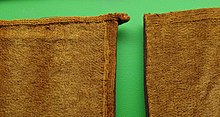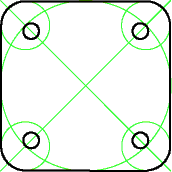Tablet weaving

The tablet weaving , also platelet weaving , is a weaving technique for the production of textile tapes and fabric edges by connecting two thread systems. In tablet weaving, the warp thread system runs through a number of weaving boards of triangular to octagonal shape made of wood or cardboard (in earlier times also made of horn or parchment ) with a different number of holes. The shed is formed by turning the weaving boards sideways. A weft thread introduced into the shed connects the warp thread system to form a fabric.
Weaving technology
Depending on the weaving technique used, warp threads are pulled into all or only some of the holes in the boards. The number of boards next to each other and the strength of the warp threads used determine the width of the resulting fabric. All warp threads must have an even tension. The surfaces of the boards are parallel to the chain. If you turn the boards in this position in one of the two possible directions, the threads of each board are twisted into a cord. With four-hole boards, a new "shed" opens after every 90 ° rotation - with a complete rotation of the board through 360 °, four pockets one after the other - each with a different warp thread on the surface so that it is visible in the resulting fabric is. The cohesive fabric is created by pulling a weft thread into the opening shed and beating it on. This holds the lacing of the warp threads together and is normally not visible in the finished fabric. Exceptions are the so-called missed hole technique , in which the weft thread becomes visible through holes in the surface of the fabric, and the speckled fabric , in which the weft thread becomes visible as a point-like structure in the fabric. With these techniques, only two or three holes in the boards are covered with warp threads.
As the warp supply also rotates in the opposite direction to the intended direction of rotation of the boards when the boards are turned, the direction of rotation of the boards must be changed at regular intervals or the strands must be untwisted individually. Depending on the arrangement of the drawn-in colored warp threads, a recurring pattern is created. One speaks here of the cord binding technique . Other techniques are the so-called two-tone weaving double face , in which the pattern is woven with only two colors. It is characteristic here that the pattern on the underside of the fabric is exactly complementary to the upper side. Another technique is called twill because the diagonal lines on the top of the fabric that result from this weaving technique resemble the body structure of normal fabrics. With the brooch technique , one or more additional weft threads can be used to create additional patterns.
history
The origin of the tablet weaving is not clear. An ivory board from Susa from the 3rd millennium BC was made. Discovered. The oldest find from Europe is a single square four-hole board from the Late Bronze Age , which was found near Göttingen. However, individual finds of this type cannot be taken as evidence of the technique of tablet weaving, as they were also used to make simple cords. Tablet weaving certainly existed in China as early as the Shang period (16th - 11th centuries BC). The oldest European tablet fabric comes from a grave in the Villanova period necropolis Sasso di Fubara in Italy from the 8th century BC. The finds from the grave of the Celtic prince of Hochdorf are the oldest German finds. They are dated to the middle of the 6th century BC. Dated. In Russia, China, India, Japan and the Arab countries, the handicraft technique of tablet weaving has continued uninterrupted to the present day. It can also be found as true folk art in Finland, Norway and Iceland.
Web links
- Reconstruction of a late medieval tablet loom
- Tablet Weaving by Lise Ræder Knudsen Research results and reconstructions on Iron Age and medieval tablet weaves (English)
literature
- Elisabeth Holzklau: tablet weaving. Tips and tricks to get you started . Frech, Stuttgart 1977, ISBN 3-7724-0264-X .
- Marga Joliet-van den Berg, Heribert Joliet-van den Berg: tablet weaving . Haupt, Bern / Stuttgart 1975, ISBN 3-258-02388-3 .
- Marga Joliet-van den Berg, Heribert Joliet-van den Berg: Woven with boards . In: Fountain series . tape 116 . Christophorus, Freiburg 1976, ISBN 3-419-52416-1 .
- Charlotte Lenz: tablet weaving . Maier, Ravensburg 1976, ISBN 3-473-42319-X .
- Karl Schlabow : The Art of Weaving Boards . In: Publications of the Förderverein Textilmuseum Neumünster eV . No. 1 . Wachholtz, Neumünster 1957, ISBN 3-529-01701-9 .
- Otfried Staudigel: The magic of board weaving. Image patterns from the Orient and 25 patterns in cord technique = tablet weaving magic . Staudigel, Krefeld 2000, ISBN 3-8311-1313-0 .
- Peter Collingwood: The Techniques of Tablet Weaving . Random House, New Zealand 2002, ISBN 1-56659-055-8 (English).
- Heidi Stolte: Technique of tablet weaving . In: Experimental Archeology in Germany, Archäologische Mitteilungen aus Nordwestdeutschland, supplement . No. 4 . Oldenburg 1990, ISBN 3-920557-88-3 , p. 434-437 .
- Claudia Wollny: Tablets at Work ISBN 978-3-00-057567-9 (basics of various techniques), roslein and wecklein ISBN 978-3-00-060775-2 (subject of brochures), Der Lilienhain ISBN 978-3-00-051033 -5 , The Fabulous World ... Arlon ISBN 978-3-00-047682-2
Individual evidence
- ↑ a b c Ruth Zechlin : Workbook for girls. Otto Maier Verlag, Ravensburg 1972, ISBN 3-473-42315-7 , p. 132.
- ↑ Annemarie Seiler-Baldinger: Systematics of Textile Techniques . Ethnological seminar at the University and Museum für Völkerkunde Basel. Basel 1991, ISBN 3-85977-185-X , p. 82.
- ↑ Heidi Stolte: Technique of tablet weaving . In: Experimental Archeology in Germany, Archäologische Mitteilungen aus Nordwestdeutschland, supplement . No. 4 . Oldenburg 1990, ISBN 3-920557-88-3 , p. 434-437 .
- ↑ Stefan Mecheels, Herbert Vogler, Josef Kurz: Culture and industrial history of textiles . Wachter GmbH, Bönnigheim 2009, ISBN 978-3-9812485-3-1 , p. 110.


